Barefoot kids have feet that are able to grow naturally leading to a healthier gait, and more. Check out these surprising benefits!
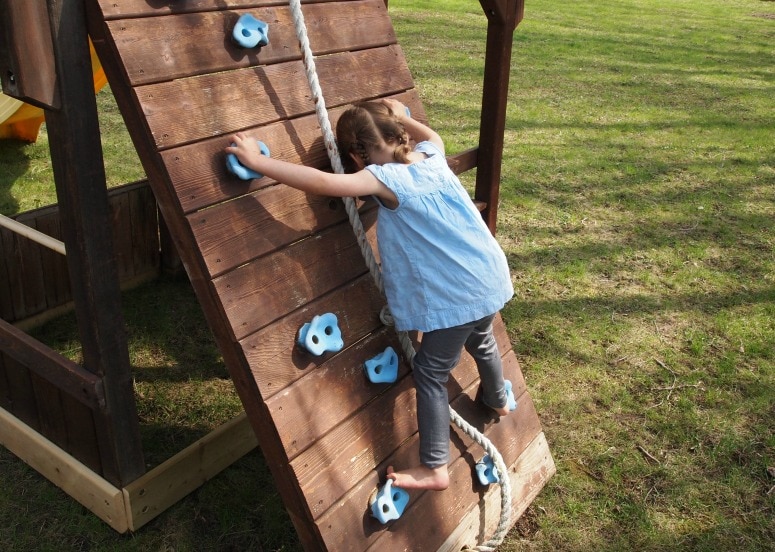
Walking barefoot through the warm summer grass. Who doesn’t feel a bit nostalgic remembering the childhood pleasure of going around barefoot? Almost anyone would agree that it’s enjoyable to kick off one’s shoes every once in a while and feel the earth beneath your feet.
But did you know there are lots of good reasons to encourage your child to go barefoot? Not just occasionally, but as often as possible?
It’s good for all of us, but little ones — whose bodies are growing rapidly — can especially benefit from going without shoes. Going barefoot is just one of the simple things to enjoy in the hot months.
Now that the weather’s warmer, I encourage my three-year-old daughter to be barefoot pretty much all the time, as I am. We keep a pair of sandals for each of us in the van, to slip on before entering a store or restaurant (It can be annoying to get hassled by a store manager for being barefoot).
Otherwise, we’re almost always completely unshod, weather permitting. If I feel like giving my feet a little TLC, I whip up a quick batch of this sea salt exfoliating foot scrub.
Barefoot kids: Why you might want to raise kids without shoes (or less shoe-wearing, at least)
Why go barefoot?
There are several benefits for kids going barefoot. Part of it is a rite of passage in childhood, but it also has some surprising health benefits.
- Feet grow and develop naturally
- Kids learn a natural and healthy gait
- Improved safety awareness
- Shoes last longer
- It’s therapeutic
- Kids sleep better (can I get an Amen?)
- Simply fun
- Overall healthier feet!
Raising kids barefoot: it’s more important than you would have thought
1. Allow Feet to Grow and Develop the Way They Were Meant To
You may never have noticed this, but shoes actually change the shape of our feet over the course of our lives.
At birth, the human foot gets wider as it progresses to the ends of the toes. (If you take a look at a newborn’s footprint, you might notice this feature). But the average adult’s foot is widest at the ball, and the toes pinch inward. Why is that? Because a lifetime of wearing shoes has actually altered the shape of the foot!
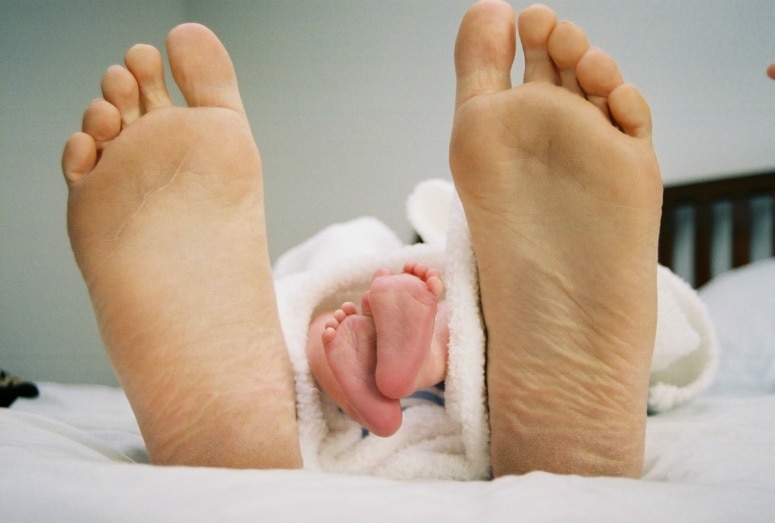
Photo via Flickr CC.
People who live in cultures where going barefoot is the norm don’t have feet like ours. The toes remain spread apart, like a newborn baby’s.
But in our culture, we like the appearance of a tapered toe on our shoes. We’ve actually become conditioned to believe that that’s what a foot should look like. So we don’t create shoes that follow the shape of the foot; instead, we create shoes that our feet have to fit into. Even if it means permanently changing the natural shape of the foot.
Beginning in infancy — when bones are still forming — we start putting our children’s feet into shoes that look the way we think they should look, ultimately changing the shape of their feet. And changing the shape will, of course, alter how effectively they work.
“The human foot is a masterpiece of engineering and a work of art.”
Leonardo DaVinvci
I tend to agree. I don’t want to mess with that. That’s why I let my daughter go barefoot as much as possible: to protect her feet, and to let them grow the way they were supposed to! Going barefoot builds great flexibility.
2. Encourage Children to Learn a Natural, Healthy Gait
Wearing shoes changes the way we walk – and it isn’t necessarily for the better.
When we’re barefoot, we naturally walk more gently, with a shorter stride, putting less pressure on our heels. Our knees bend to cushion the shock of each step. Our toes grip the floor and help propel us forward.
Shoes change all that.
The cushioning on our soles encourages us to slam our heels into the ground, which is harder on our knees. The stiffness of our soles prevents our feet from rolling flexibly forward, so shoes are given an upward-curved toe — called a toe spring — to allow them to rock forward onto the next step. This toe spring lifts our toes off the ground, so they can’t help propel the foot forward as they’re meant to. Our feet get trained to use the wrong muscles to move us forward.
All of these things together mean an unnatural gait that is harder on all of our joints.
If you consistently put shoes on your children right from infancy, they learn this unnatural gait from the start. They never get the chance to strengthen their toes and the tendons in their feet that are supposed to do the bulk of the work. These muscles atrophy, so that when kids finally do take off their shoes and try to run around, it can hurt. Foot pain may be avoided by simply starting without shoes. Natural walking is best learned without shoes and leads to the healthy development of the feet.
Give your kids a chance to learn the right way to walk by letting them go barefoot as much as possible. Kids’ feet need a chance to be free.
3. Improved Safety
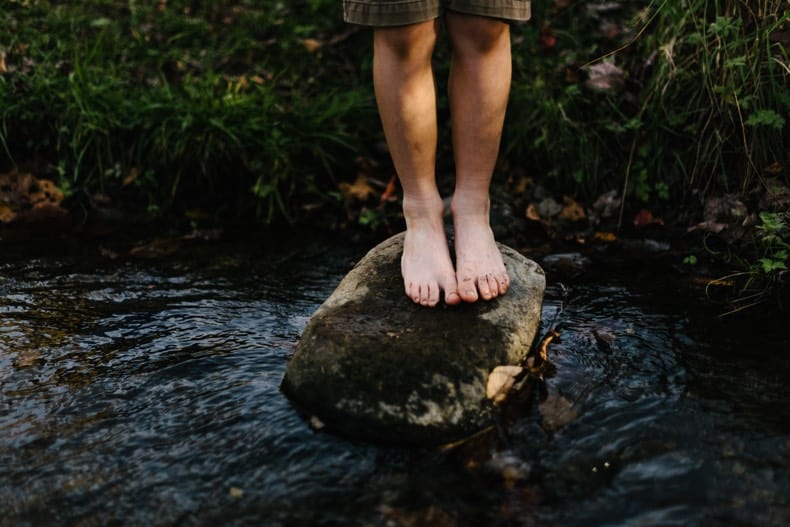
Going barefoot everywhere
I know, I know, I know. The number one reason most people put shoes on their kids is for their safety. To protect their feet from hard, sharp surfaces. But it’s my opinion that in most situations, wearing shoes is actually more dangerous than going barefoot. Barefoot kids are able to develop motor skills essential to gripping as they climb and run about.
In my personal observations, children are much more likely to trip and fall when they’re wearing shoes – especially flip-flops and Crocs. (In my opinion, flip-flops are the most dangerous thing you can put on your kid’s feet, and they’d definitely be better off barefoot).
Most shoes in general, but especially the slip-on variety, tend to make kids clumsier because they make the wearer less alert to his/her surroundings. They require effort to keep on, and they shift and slide under their soles as they move, making their footing less stable.
I haven’t seen any studies done on children and footwear, but a 1991 paper entitled “Athletic Footwear: Unsafe Due to Perceptual Illusions,” published in Medicine and Science in Sports and Exercise, noted that athletes who wore fancy, expensive athletic shoes are actually more prone to injury: “Wearers of expensive running shoes that are promoted as having additional features that protect (e.g., more cushioning, ‘pronation correction’) are injured significantly more frequently than runners wearing inexpensive shoes (costing less than $40).”
According to another study, people in expensive cushioned running shoes were twice as likely to suffer an injury than were people who went running in hard-soled shoes. Because we think we’re protected, we move in ways that aren’t safe for our bodies.
What are they going to wear, then?
If you want some sort of shoe, then the ideal is to choose flexible-soled shoes that strap on securely, like leather moccasins, so they can still feel the ground under their feet, but not slip out from under them as they play. This is particularly important when considering children’s shoes.
But what about sharp objects? Don’t barefoot kids’ feet need protection from them?
That’s a valid question, and obviously you need to assess the nuance of your environment. But it’s been my experience that kids (and adults) who are used to going barefoot have a heightened awareness of their surroundings.
When we go barefoot, we instinctively pay attention to where we’re putting our sensitive feet. We watch the ground in front of us and use common sense. And because we step more gently when we’re barefoot, we’re apt to notice if we’re starting to put our foot down on a sharp object and quickly lift it, avoiding puncture wounds and other injuries. The more often you go barefoot the thicker the skin on the soles of your feet becoming creating natural protection.
Going barefoot allows for full freedom of movement and encourages safety.
4. Healthier Feet and Increased Brain Devolpement
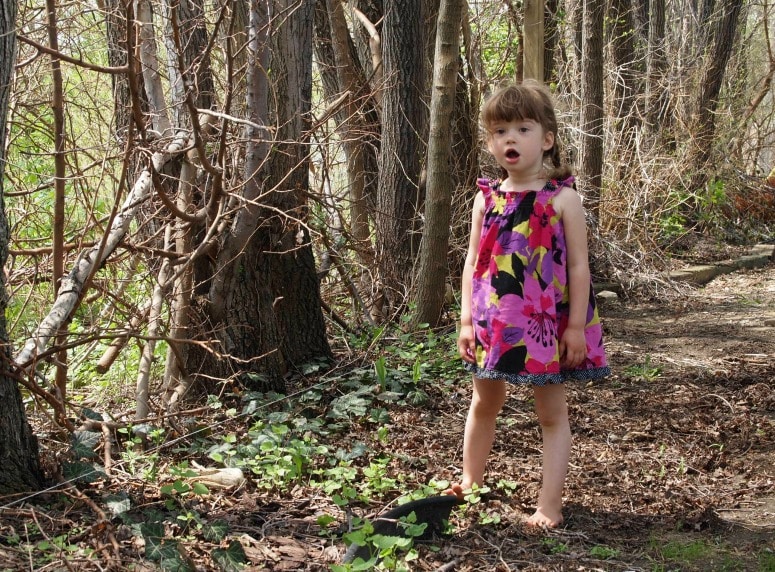
Shoes trap fungus and bacteria and hold them against your feet. They also provide a lovely, warm, damp environment for them to grow in, inviting things like athlete’s foot and toe fungus and encouraging ingrown toenails. Ditching the shoes more often creates healthy feet.
So keep your kid’s feet healthy by keeping them bare! Sunshine and fresh air are great for feet, too! Barefoot children may have increased brain development allowing them to build confidence, have better problem-solving skills, social skills, language skills, and better regulation of emotions. (Bridging the Gap)
Spending time barefoot outdoors is beneficial to the nervous system. The feet have over 200,000 nerve endings that gather information. When there is no barrier, the brain is allowed to better connect with the feet and improve cognitive development. This is one of the reasons earthing or grounding is becoming more popular amongst adults.
That sensory connection allows children to be in tune with the world underneath their feet through outdoor play and develop their gross-motor skills.
5. Less Wear and Tear on Shoes
My daughter has only owned a few pairs of shoes in her short lifetime (all second-hand). They aren’t worn often so I will be able to pass them on to her siblings.
This would probably be a silly reason to go barefoot if it was the only one, but it’s a really nice side-effect.
Raising Barefoot Kids: Expert Tips & Tricks
How to start going barefoot
Start off slow. If you have worn shoes inside and outside most of your life your feet are not used to being without them. The muscles in your feet need to be retrained on how to move. The soles of your feet also are more tender because calluses have not been allowed to develop.
Start off going barefoot inside your house or on the grass. You will be amazed at how cathartic it can be to walk barefoot through the grass. Once your feet have accustomed themselves to being barefoot around your home start walking around your neighborhood on the sidewalk or through the dirt.
How to go barefoot in public
I have been going almost exclusively barefoot for the last five years, and my daughter for the last three (except in the colder weather of course), and neither of us has suffered any kind of injury from a sharp object yet. I recently walked all over Toronto and Montreal without incident.
My daughter and I regularly walk all over town and the local parks and walk to and from the library weekly. We’ve never gotten anything worse than a nettle thorn in our feet. Children’s feet grow best when they are able to not be restrained to shoes.
Take a pair of shoes for yourself and each of your children to slip on when you get to a store.
Is going barefoot bad for your feet?
As a whole, no. Obviously one needs to use common sense. If it’s hot outside, you aren’t going to want to walk barefoot on concrete or the blacktop because it will burn your feet. If you live in a developing nation or an area of town where you might be exposed to human and animal waste or drug paraphernalia, then walking barefoot should be saved for the safety of your own home. Similarly, you should avoid going barefoot in public restrooms and locker rooms.
Should babies wear shoes when learning to walk?
Let those little piggies wiggle free. If babies wear shoes while first learning to walk they learn an unnatural gait. It is better to allow them to learn to walk barefoot to strengthen their toes and the tendon in their feet before you introduce shoes. Going bare foot is important for early walkers.
What about when I have to wear shoes?
It comes as no surprise that you can’t go barefoot 100% of the time. There are places, seasons, and times that you have to wear shoes. While the best option is going barefoot, the next best thing may be a minimalist shoe if you are looking for a compromise between going barefoot or wearing shoes. Minimalist shoes are designed to mimic the benefits of going barefoot.
Just because they are called minimalist don’t let yourself interpret that as boring. They are anything but that. I’ve come across a wide range of styles. The only thing you probably won’t find is heels since that defeats the purpose of barefoot shoes.
There are high-quality shoes that you can invest in to encourage your kid’s feet to grow as healthy as possible.
They make sandals, tennis shoes, dress shoes, and everything in between. There are shoes made from vegan materials or other natural materials like suede leather, and all sorts of different colors. So, whether you are looking for minimalist kids shoes or pair of shoes for yourself, you are sure to find something.
Let’s de-mystify some of the terminologies that you might see when you are looking for minimalist shoes:
- Zero drop– Also called zero-drop platform, these are shoes with a heel that is not elevated to aid in proper posture.
- Wide toe box– Allows toes to spread out and relax, just like they were created to do. Many traditional shoes taper at the toes.
- Flexible sole– These soles are low to the ground, allowing feet to bend and flex, increasing balanace and agility in a way that stiff soles don’t allow for. The bottom of the feet are able to feel the ground.
If minimalist shoes aren’t in your budget, prioritize shoes that have thin soles and a wider toe box.
This is one of the more popular, longstanding brands that has been making minimalist shoes for a while, but there are other popular brands. There are also cheaper versions of minimalist shoes without the brand recognition out there that may work for your needs – do a bit of research and read the amazon reviews to sort through them.
The bottom line: Encourage your kids go barefoot
Encourage your kids to go barefoot as often as you feel comfortable. Kick your shoes off and take a barefoot romp through the grass as a family. Soak in the warmth of the summer day and have fun!
Are you raising barefoot kids? What tips do you have?
Resources for Further Reading/Learning
You Walk Wrong by Adam Sternbergh
The Foot Film (trailer)
Original Post written by contributor Kathleen Quiring & published in 2014. It has been updated & expanded by Red & Honey in 2021.

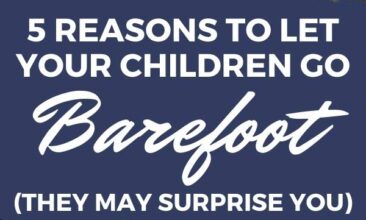
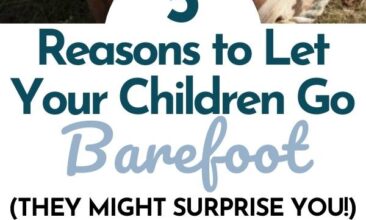
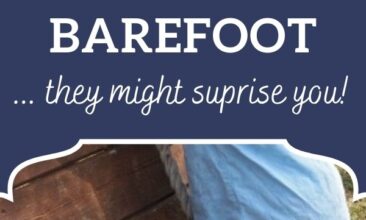
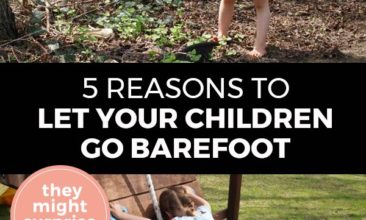
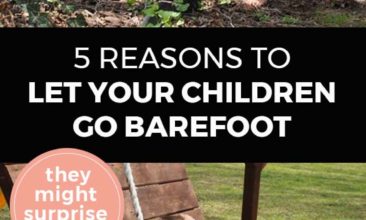

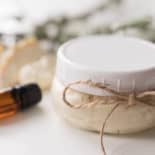









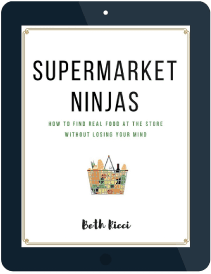
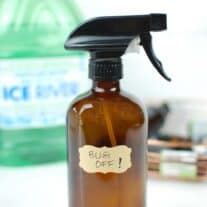

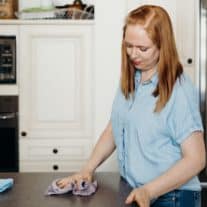




Constance Beth
Wow! It looks like the all the “Anti-Bare Footers” are awfully angry and tightly wound! Maybe that is another backlash of wearing shoes that are too confining your entire life!! Ha ha
Maryam
Going barefoot in places where it’s relatively safe is great, and I’d recommend it for kids and adults.
Wooded areas, however, are not safe for bare feet. Walking in the woods should be done in boots — not bare feet, not most shoes or sneakers, and definitely not flip-flops. Boots. Which are generally cut for a more natural foot shape if they’re proper boots.
(I’ve spent most of my life in the country, work in a remote undeveloped place, and spend a lot of time outdoors. The boot thing has been drilled into me from an early age, and I’ve had plenty of occasion to be thankful I’ve followed it.)
Xerxes
The more time you spend barefoot, the tougher your feet will become. I can run barefoot on gravel because I spend a lot of time, especially when I’m outside in or out of public, barefoot. If I see a kid with shoes off a lot I’ll trust their judgement to be ready to step on glass, even though I don’t support them always. And one key thing, too. Blisters. Those are much worse than a scratch. But bring some ointment for an infection if bare feet bothers you.
I would wear shoes because they keep your arches higher, and they are less distracting than the unearthly smells coming from bare feet.
Carly
Every chance I get I take off my shoes. Have done so since I was a kid. Mom would tell me to put on shoes, but the moment I was outside – off they came! So, I unwittingly saved my feet from being ‘bound’, they are shaped as they were meant to be. I have a very high arch (and naturally slender but long foot) and find it impossible to find shoes that fit okay. I loathe how shoes seem to have the toes raised above the heel, they are impossible to walk in (at least for my barefoot loving self). I don’t like flats, they just don’t feel right, but I’ll see about tracking down some nice moccasins. They sound like what I need. For now, my kitten heel sandals do the trick.
As far as kids getting into bee stings and nettle, eh, it’ll clear up. And infections? I have more toenail irritations and infections when I wear shoes too long, not from being barefoot. I still go barefoot with cuts, just have one heck of a giant band-aid on the wound.
Lauren
I’ve transitioned into letting my four daughters choose to be barefoot whenever they wish. Most of my true hesitations had to do with my own internalised judgements about people who didn’t wear shoes.
http://www.sparklingadventures.com/?id=1913
My girls are now barefoot, healthy and free!
Leonie
I’d say that reason 4 (less wear) isn’t all that important today. Which shoes don’t hold up until children grow out of them?
It was certainly different 100 or 200 years ago when shoes were costly, hand-made items made to measure and intended to last many years. Not so affluent families had different priorities than to provide their children with shoes for every opportunity, and why would they have to when there’s no social obligation to wear shoes (except to special occasions) and they enjoy going barefoot just as well, most of the year?
Then again, shoe-shopping, endlessly trying on shoes to find a pair that fits, looks and feels good, is a very tedious activity for children. I guess I had some of my most boring moments of childhood in shoe shops. Many children wear shoes that don’t fit right, because they are too long, too short, too wide or too narrow. Walking barefoot however is the “shoe that always fits” through all the years of growth.
One real danger are bee stings, so children should be watched in flowering meadows and taught as early as possible to watch out for bees. Flowering clover seems to be especially attractive to honey bees and is so close to the ground that one could easily step on a bee and get stung.
One potential difficulty would be social pressure in kindergarten or school if a child is the only one coming barefoot. Then it will be important to have moral support from parents and friends – and it might be worth if parents speak to teachers to ensure no derisive comments will come from them. Not all kids have the robust self-esteem to ignore any hostility they may encounter for not fitting in. (Building up said self-esteem would be a worthy goal of childraising however: Learning to be yourself without wanting to be the same as all the others.)
MamaV
Hooray! My two year old is always the one with slacks, a button down, and bare feet in Sunday School 🙂
The big issue where we live is that in the summer, the ground is just too hot to walk on (like, you could fry an egg on the sidewalk). I stick a pair of sandals on the boy if I need him to walk any distance, but otherwise he just goes barefoot and stays off the concrete. The moccasin idea would fix that problem… I like five-fingers for myself.
unci
That’s certainly cute and would be worth a picture!
The ground being too hot is usually a problem with paved grounds. Natural trails, grass, mud don’t get terribly hot. So it depends on the area … in most cities there’s a chance to flee to the shadow of buildings.
Lynne
I find it a bit funny that at the end of all these comments, there is an advertisement for shoes.
unci
Great article! You could make a PDF flyer of it, to distribute to all parents worrying their children will get hurt or sick when they go barefoot. This should be distributed to birth clinics and kindergartens worldwide!
Of course there are many more good reasons. It is simply so practical not to have to sit down and tie your shoes when you go out, and so quick and easy to wash feet as you come back home.
And it teaches children to use their natural sense of temperature. They get used to the warm and cold and learn by own experience how cold is still ok, how cold is too cold. Too many overprotective parents worry that it may be too cold for their child when the child is actually fine and will say if it gets too cold.
Shaina
Is there a type/brand of shoe anyone could recommend for times when shoes are necessary?
Constance Beth
Absolutely! I only wear Birkenstocks. ( No, I’m not a Hippie left over from the 60’s.) Haha I have a few pair of beautiful dress heels that I will wear on special occasions, or to appropriate events. But my everyday wear are a pair of Birkenstocks. They are made to form the foot to it’s natural shape. The toes are never squished together, and the heel is allowed full freedom to take it’s natural shape. These shoes have a cushy arch where the natural arch of your foot is. I am in my 60’s and have never had any type of leg or foot problems. When I am forced to wear a pair of Dress Shoes, my feet always ache for hours afterward. I spent time in Germany when my children were very small. Almost all the shoes for Children in Germany are very different looking then what you get in the States. At first I didn’t want to dress my little girls in such chunky looking shoes. The toes of these shoes are very wide and the over all look of the shoes are anything but petite looking. I got use to the girls wearing these wider more sturdy shoes, and know I look back a pictures and find them very endearing. If you get a chance, Google Children’s German Shoes. You will see what I mean. I didn’t know it at the time, but I honestly believe that these shoes helped my girls feet to grow more naturally.
Emmanuella
I found professional looking barefoot shoes for work at LemsShoes.com.
Heidi @ Barefoot and Paleo
We have a good list of minimalist shoes at http://www.barefootandpaleo.com/2014/02/barefoot-minimalist-shoe-guide.html?m=1
Amie
My concern is hook worms. http://pets.webmd.com/dogs/hookworm-in-dogs
Kriss
Amie, the article in the link you quoted was very good, but it addressed hookworm infection in animals, specifically dogs, not human hookworm.
Hookworms from any animal feces are not the same type of hookworms that we generally hear about that have been known to infect humans. Human hookworm infections – those that affect the digestive system – can only come from frequent and direct contact with infected human feces – that is, feces left on the ground by a human being who himself/herself was infected by hookworm before leaving the feces. A highly unlikely scenario in modern-day America or any other developed country with modern sewage systems.
However, as the article mentions in the last paragraph, there is one type of hookworm sometimes found in dogs (and cats) that does have the potential to infect humans, but only causing a minor skin irritation. This is actually rare, as best as I can determine, but in any case it seems nothing to worry about, for as the article states (which is also backed up by the CDC), “An itchy disease in humans called cutaneous larvae migrans (creeping eruption) is caused by the hookworm A. brasiliense. Larvae present in the soil penetrate the skin, causing lumps and streaks beneath the skin. The condition usually clears up on its own.”
So hookworm – in any form – is not something we need to worry about with our children running around and happily playing barefoot.
Dianna @ The Kennedy Adventures
I’m glad you addressed the hookworm ‘controversy’ ….. I shared this article on my FB page and got the same response.
Jen
One of our children was infected by going barefoot! I don’t remember what type of worm it was, but it required a very expensive, heavy duty drug to kill. I agree with the many benefits of going barefoot, but infections are a very real danger that we learned first hand.
Kayla
I really enjoyed this article. At my son’s 2 year check-up recently, the doctor commented, “Oh. He goes barefoot a lot, doesn’t he?” I couldn’t tell if she was approving or disapproving, but he definitely does! He had a high arch as an infant that made finding shoes that fit nearly impossible. We opted for Robeez during the pre-walking winter months and beginning stages of walking, and they seemed to work really well.
I hadn’t really considered the heightened sense of surroundings when walking barefoot, but it’s so true! I have extremely tender feet, so any invaders — tiny or large — are avoided whenever possible. Thanks for sharing these thoughts!
Eva
A comment from a co-worker when talking about not wearing shoes was that “It’s so unsanitary!”. Really? Unsanitary? How?? I understand that if you had an open wound/cut on the bottom of your foot how this could then be “unsanitary” per say (chance of infection etc.), but if your feet bottoms are intact this makes no sense. If you think about it our hands touch far more unsanitary surfaces (door handles, any surface in a public place really) and we don’t go around wearing gloves to protect them.
Amanda
I went barefoot often as a child and pretty much constantly since I became a stay at home mom. It’s convenient, and I agree it’s important for babies and toddlers learning to walk/balance to be able to feel the ground with their bare little feet. I also agree about enclosed sneakers/shoes trapping moisture. However, there are negatives to going barefoot that you didn’t mention. Going barefoot causes you to lose your arch and can cause foot pain while working on hard surfaces, like tiled floor in a kitchen. My mother has gone barefoot almost her entire life (stay at home mom as well), and has had many problems with her feet as a direct result. Her doctor now has her wear new balance sneakers for “house shoes,” which have alleviated some of her foot pain. Also, going barefoot has (as you mentioned) caused her feet to spread, and she has a lot of difficulty finding shoes that will fit her wide feet.
c
After working many many years in a factory on cement floors, I can assure you that hard surfaces hurt your feet with shoes just as much as without.
For me, losing the arch support of shoes has been nothing but a blessing. Since I started walking barefoot and lost the artificial support from running shoes like New Balances (which is what I wore up until my arch pain got so bad I couldn’t walk more than a mile without being crippled for days) the muscles and tendons in my feet have strengthened and gained flexibility, and arch support is redundant because now my foot supports itself. And now I have NO foot pain when walking.
Jeanne
Thank you! If I’m on my feet too much whether I’m barefoot, wearing sneakers, flats, or heels, they hurt. Being a former dancer, I know to stretch my feet just like any other body part and my feet are neither flat or have too much of an arch and I still have full range of motion in my ankle since someone recently made a comment to me about wearing high heels too much.
Kriss
Amanda, I’m sorry to hear of all the foot problems your mother has had, but going barefoot does not cause “you to lose your arch.” It’s the opposite, in fact. Wearing shoes, especially those with arch supports, actually causes the muscles and tendons of the arch to weaken and atrophy. Going without shoes over time strengthens all the parts of the foot. If your mother went barefoot all her life, and then had foot problems, I’m afraid it is simply faulty logic to assume one caused the other. Thousands – actually millions – of people around the world, especially in earlier and ancient times, went barefoot all their lives – many remote tribes still do – and had strong, healthy feet. Going barefoot is the natural function of the human foot. It was not designed to need support or covering for it to function normally. Whatever foot problems your mother has, had to have been caused by some other physical or medical malady, certainly not by going barefoot.
Alan
Amanda, you said: “Also, going barefoot has ….. caused her feet to spread”
Actually, going barefoot has allowed her feet to assume their natural morphology, unlike so many Westerners whose feet have been bound in shoes and are now deformed and unable to function as designed.
Sarah D.
I’m not sure going barefoot would cause arch problems or widened feet. My feet have always been narrow, especially my heels, and I don’t have arch issues. My husband, however, has flat, long, skinny feet. It may be hereditary or maybe putting his feet in shoes as a baby is the culprit. My mother-in-law has said before that I should put shoes on my babies, but I disagreed. =) Our 5 1/2 yo has long, skinny feet; 4yo has very wide feet; 2yo has “normal” feet; we’re waiting to see what kind of feet new baby has. Everyone’s feet are different, just like every other part of them. =)
Chris
I went barefoot all around town growing up, only put shoes on to go to school for the most part unless it was really cold. Now at 30 years old it is very difficult to find shoes that fit me. I can fit into a 9 if it has no sides but more often then not I’m in a 10 or 11 wide just so the sides fit. As for the safety part, it’s a mix, we have a wood deck and my kids are forever getting splinters and the park has those infernal bark chips under the play structure, we’ve never noticed the tripping issue with or without shoes. I like the moccasin idea though.
Heidi @ Barefoot and Paleo
Wonderful! We need more positive posts about going barefoot. I love watching my kids run (super fast), hike, and walk barefoot. Other than some chestnut spikes in the heel, we haven’t had any issues.
We also go barefoot into the market and restaurants. Usually without hassle.
Theresa
I grew up running around the neighborhood barefoot, so I’m huge supporter of this life style.
However, since becoming a veterinarian, I’m more aware of the potential dangers of going barefoot; namely, parasites such as hookworms which can cause cutaneous larva migrans. Hookworm larva enter the body through the skin, and migrate through out the body causing organ damage and a rash. Young children are most susceptible to worm migration because their immune system isn’t fully developed.
Here’s a few tips to protect your children while they explore the great outdoors barefoot!
1. Keep all family pets (especially those utilizing the backyard as a toilet!) on heartworm prevention, which also prevents against many intestinal parasites, like hookworms
2. Have your veterinarian run a fecal test from your pets at the beginning of the summer, so that any current infection can be treated before the kids are running around the yard
3. clean animal feces up from the yard daily. This removes eggs from the area, before they hatch into infective larva
4. avoid going barefoot in animal pens or kennels where parasitic loads are higher
I’ll be barefoot this summer along with all of you so lets make it a safe one!
Kriss
Theresa, it is true that animals are certainly susceptible to various types of worms and other parasites. However I think your warnings regarding animals and parasites are a little overblown. I’m sure you know, with a few exceptions, animal diseases and infections are species-specific. For example, the type of hookworms commonly found in dogs and cats, that have invaded their gastrointestinal system, are about the only animal hookworms that will even infect humans, but they do not infect humans the same way as they do the animals. At worst, it becomes only a mild skin rash (cutaneous larva migrans), easily treated, and usually goes away on its own even if not treated.
Even if a pet that’s infected with hookworm is allowed to go untreated, and a child walks barefoot in the pet’s infected feces, the chances of the larvae actually boring into the child’s skin and therefore causing the skin rash is not likely unless the child is allowed to remain in the feces barefoot for a long period of time. Hardly likely for any responsible person who normally takes good care of his/her pets, as well as, of course, his/her children.
Walking barefoot in the feces of other animals, such as farm animals – chickens, cows, horses, etc. – has never been found to cause any infections, parasites, or any other medical problems.
I certainly don’t disagree that yards and other places children may play – barefoot or not – should be kept cleaned up from animal feces. But the main reason is aesthetic, not medical.
Cindy
So you’re a Dr or Veterinarian are you Kriss?
You say…. “I’m sure you know, with a few exceptions, animal diseases and infections are species-specific”… well in fact this is inaccurate
There are MANY Zoonotic diseases. We have a couple in the clinic where I work at present which require us to glove, gown and mask up before entering the isolation area they are in.
Visceral larva migrans for instance – which are acquired from roundworm who are the most common parasite of the digestive system in cats and dogs. Roundworm can spread to humans via ingestion of roundworm eggs. This can happen when a child comes in contact with contaminated soil or sand and then inadvertently transfers the eggs to their own mouth via contaminated fingers (from scratching their foot after walking through an egg laden area, or sitting on/playing in the grass etc) or by putting contaminated objects in their mouths.
Visceral larva migrans also known as Toxocariasis is a potentially serious disease that can affect the eyes and other organs. After the eggs are ingested they hatch in the human intestine. The larvae from these eggs are then released into the bloodstream and find their way to all parts of the body, including the liver, lungs, heart, brain and eyes.
And as for your remark about farm animals… Salmonellosis and E coli can be contracted by contact with the contaminated faeces of farm animals, as can Campylobacter and Cryptosporidium. And these aren’t the worst zoonotic diseases you can find on a farm!! Also these illnesses are not only found on farms – we have a cat with Cryptosporidium in isolation in our clinic at the moment. And don’t forget that cats (and dogs) often roam in childrens parks, and will often pee and poop in sand boxes etc.
I completely agree with Theresa 🙂
Kriss
Cindy, thanks for the information, but nothing you said really contradicts anything I said. Since the article, as well a Theresa’s comments, were about “…the potential dangers of going barefoot,” my comment also specifically addressed that topic. You, on the other hand, have taken my reference to “a few exceptions” out of the context of animal diseases that can spread to humans through contact with bare feet, and have expounded the topic into many other types of zoonotic diseases that have nothing to do with children being barefoot. Each and every disease you listed (Campylobacter, Toxocariasis, Salmonellosis, E. coli, and Cryptosporidium) can only be spread to humans by ingestion, not by merely coming in contact with someone’s skin.
Certainly there are “many” zoonotic diseases, as you stated, including such things as anthrax, rabies, plague – the list goes on. But we’re not talking about those diseases here. We’re talking about “potential dangers,” if any, of children going barefoot. All the diseases you listed could indeed potentially infect a child – or anyone. But a child being barefoot or not has no relation to the spread of such infections.
Victor Sudakov
Cindy,
Of all the zoonoses you have enumerated, which are barefoot-related or those which pose a special risk to a barefoot person? I suppose about 0% if I have read your comment correctly.
Sarah D.
Well, one more reason not to get a dog…
Snoopy
I am going to bite you.
Seriously. I am going to bite you and poop on your rug.
#dogsareawesome
Lisa Suit
My three kids and I are always barefoot at home (outside and in) and only put on shoes when we go somewhere. When my kids are babies I never put shoes on them, until they are walking well. I just prefer being barefoot (or socks in the winter), but when our oldest was just starting to walk well I noticed that the first solid soled pair of sneakers she had (vs the soft soled moccasins she had worn places before) caused her to stomp, because she couldn’t feel the floor! That reinforced my barefoot cause, and my second and third children haven’t even worn those little moccasins. It’s nice to see there is actually scientific basis behind my neurosis, lol.
Amanda
There are no links to “scientific proof” to back her info up so the most we can take this as is her own opinion.
Tracy
Actually, in section 3, paragraph 4, she cited a “1991 paper entitled “Athletic Footwear: Unsafe Due to Perceptual Illusions,” published in Medicine and Science in Sports and Exercise, noted that athletes who wore fancy, expensive athletic shoes are actually more prone to injury”
I’ve spent all of my 48+ years going barefoot all of the time; only putting shoes on for school, work, or going into stores and then only wearing sandals. I wear paddock boots when I ride and slip on clogs to care for my horse & chickens. I’ve had 2 foot injuries; both happened with footwear on; and have never had any issues with infection of any kind. I was born with a slightly high arch and 48 years later I still have it. Barefoot, sandals and paddock boots are the only footwear for me.
Alan
You can find all kinds of scientific proof. Just Google Dr. Daniel Lieberman (Harvard), or Dr.Daniel Howell , or Dr. Irene Davis, or Dr. Shakoor/journal of rheumatology. The science is there.
Sarah D.
Lisa, I’ve noticed the same response with my children when they put on hard shoes. If my babies need to have something on their feet before they’re walking well, I put soft shoes on them or socks that look like shoes. =) Those first hard shoes, though, always trip them up.
Elsie
Very interesting! We wore shoes when we went out, but my mom let us run barefoot for long hours outside. My sister, cousin, and I used to revel in “toughening up” our feet for summer. We did things we probably shouldn’t have, like run across stones and thorny ground on purpose, but the goal was to get our feet rough and ready for any ground we might cover, all summer long.
Rebecca
This makes sense. I have lived in Panama now for over 9 months and have worn sandals or barefeet almost all the time. Only when I go back to the states for a visit do I get my Skechers out. My toes now seem more spread out than they used to be.
🙂
Marissa
Our three girls go mostly barefoot from about April to November and prefer not to wear shoes. Living on a farm it equals filthy feet but I love seeing them running all over with barefeet. I try to remember to keep a pair of shoes for each in the vehicle during the summer months for going into stores but we have ended up with them wearing ridiculously mismatched shoes more than ones. Think really ridiculous like a cowboy boot and and a too small dress shoe!
Beth
Ha! That’s such a funny picture in my mind! Were they happy about this mis-matched scenario? I have a feeling my kids would think that was fun – Isaac likes to wear two different colours of shoes on purpose 🙂
Marissa
It is a little hilarious and would be embarassing only I don’t have enough time to be embarrassed these days!;). The girls on the other hand (usually Cecily) could care less, matters not how it looks as long as it gets them from point a to point b. 🙂
Joe
My wife (may she RIP) grew up in farm country. During the summers she and her sisters would walk/run through the nearby cow pastures barefoot into to what cowpies were left behind. She said it was fun walking in the cowpies, watching it and feeling it squish between her toes. Me, who grew up in the suburbs, would probably take a different opinion.